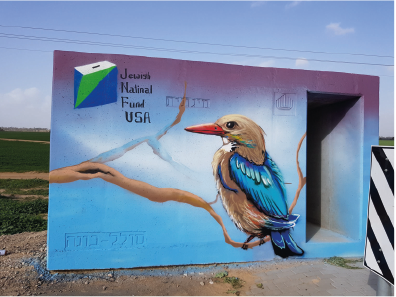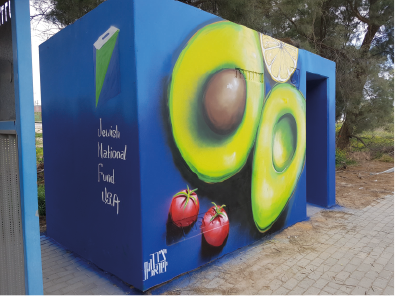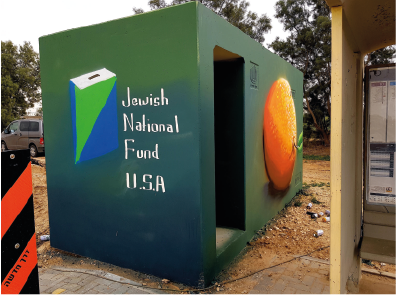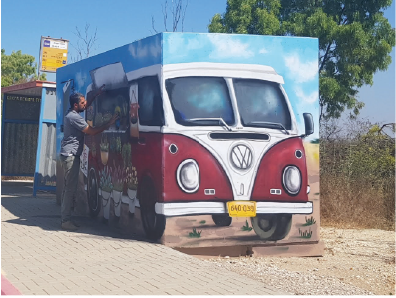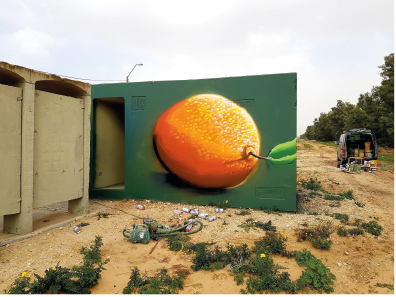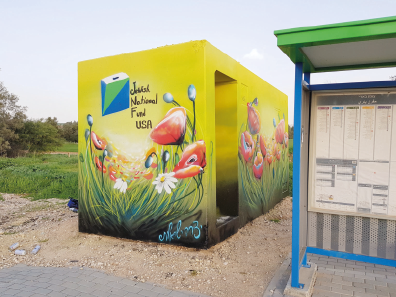About the Artist
Elyasaf Miara
If you happen to pass a huge concrete block standing like a sentinel on Road 232, and nearby you spot a tall, dark haired, handsome man, slightly graying at the temples, (sort of a younger George Clooney style) sporting a beard and a baseball cap, wearing paint-splattered clothes and a protective mask, you’ve probably caught our talented artist in action, decorating one of the 170 (and ever-increasing) roadside bomb shelters!
Elyasaf Miara: Jewish National Fund-USA’s “in house graffiti artist”
The scenery of our region is speckled with ugly cement cubes, placed around different roads in our area, near bus stops and public buildings, strategically located safe places to duck into when the Code Red incoming rocket alarm sounds. 36 year old Elyasaf Miara turns these necessary eyesores into works of art, beauty and joy. He was born in the southern city of Ashdod, and moved to the Gaza Envelope region when he got married and relocated to Moshav Shokeda, to raise his family. Elyasaf trained as a professional educator and school guidance counselor, but then, he first saw the first ugly shelter situated right at the entrance to his beautiful community. Little did he know it, but that was the moment when his profession was about to switch trajectory. That’s when he turned to his community’s administration and asked permission to transform that ugly structure into something a little less intimidating. This was not long after Operation Cast Lead in 2008. As always, word spread quickly in the Western Negev, and it didn’t take very long for other communities to turn to him, asking that he beautify their shelters, as well. Eventually, people from the Jewish National Fund-USA discovered his talents and now, he has turned his love and his talent into a full time job.
Behind the Scenes of JNF Art Shelter Decoration
In planning his designs, he takes into account the surroundings in which the shelter is situated, as well as requests of the donors, who get final approval. Sometimes, the artist and the donors collaborate to come up with the concept and design. This is no ordinary job, as Elyasaf sees it. He feels it is a special mission building connections between the donors from abroad and this region of Israel. Donors, upon their trips to Israel, always pop down to pay a visit to “their shelter” and the surrounding area. The clips that Elyasaf makes, which document the creation of the painting, are sometimes used as birthday presents for donors to give to their loved ones in whose names the donation and artwork were dedicated.
Planning each shelter takes a few hours, and then, between 10 -12 hours to be brought from drawing board to fruition. Sometimes, he gets help painting the shelters – like, for example from youths, doing it as part of a specific morale-building educational program in their community- but, for the most part, Elyasaf flies solo. Once his work has begun, he continues, no matter what the security situation. He has actually had to take cover inside one of these shelters, mid-paint, making his workplace, in his own words: “The safest place in the world to work”.e.
Reactions of the Gaza Envelope Community
In the reactions of people who live in the Gaza Envelope you can feel the outpouring of love and appreciation for this project. People come up to him, grateful for his whimsical works of art that dot the landscape, keeping us both safe AND cheery. Sometimes, you might overhear conversations, people guessing the theme of the next shelter.. Elyasaf once received a phone call from a woman, living in one of the moshavs in southern Eshkol. She told him the story of how her 2nd grade daughter was late coming home from school. After 20 minutes of worry, the child walked through the door explaining that she had disembarked from the school bus at an earlier stop in their community because of the beautiful shelter there – since the shelter near THEIR bus stop wasn’t decorated.
As a father of five who is raising his family in the Gaza Envelope, he lives the conflict and the complicated security realities every day. Elyasaf explains that this project, born from the heart, has springboarded into beautiful threads, connecting our communities in this region, and the international community, with care and love.
